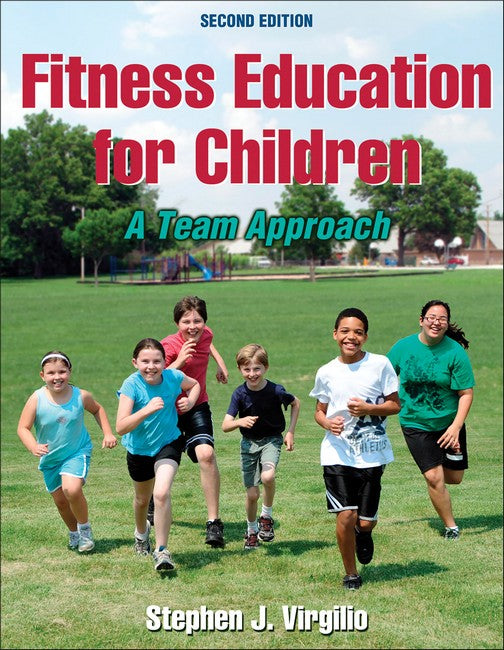Stephen J. Virgilio, PhD, is a professor of physical education at Adelphi University in Garden City, New York. He has researched and studied childhood obesity and fitness education for over 30 years. He taught elementary physical education for six years before earning his doctorate from Florida State University. Dr. Virgilio has authored four other books, including Active Start for Healthy Kids (Human Kinetics, 2006), which focuses on children ages 2 to 6. He has published over 75 manuscripts and conducted more than 150 presentations and workshops, including several keynote addresses. He is the coauthor of the nationally known Heart Smart Program, a school-based cardiovascular health intervention program. Dr.Virgilio has been quoted in over 100 major newspapers, magazines, and websites. He has served on the editorial board of Teaching Elementary Physical Education; Journal of Physical Education, Recreation, and Dance; and Strategies. He has also served on several national committees and projects with the National Association for Sport and Physical Education (NASPE). In 2006, he was elected to the NASPE board of directors. He has been a consultant to school districts throughout the United States as well as Dannon, Fisher-Price, Sport-Fun, and Skillastics. He has also served as senior writer to the PBS children's TV show Kid-Fitness. Since 1977 he has been a member of NASPE and the American Alliance for Health, Physical Education, Recreation and Dance. Dr. Virgilio resides in East Williston and Seneca Falls, New York. In his spare time he enjoys bass fishing, kayaking, boating, traveling, and studying world economics.
Request Academic Copy
Please copy the ISBN for submitting review copy form
Description
Part I: Developing a Foundation Chapter 1: A New Perspective in Elementary Physical Education Heart Disease Begins in Childhood Physical Activity as a Key Factor National Physical Activity Plan NASPE Physical Activity Guidelines for Children Physical Activity Philosophy Components of Health-Related Physical Fitness Sport-Related Physical Fitness Fitness Education Summary Chapter 2: A Team Approach to Fitness Education Mixed Messages Multidisciplinary Team Approach Comprehensive School Physical Activity Programs Let's Move and Let's Move in School School Wellness Plan Health-Related Physical Fitness Testing Youth Fitness Tests Authentic Assessment Summary Chapter 3: Behavioral Change and Motivational Strategies Rainbow to Youth Fitness and Active Lifestyles What Motivates Children to Move? Types of Motivation Motivational Strategies Summary Chapter 4: Principles of Health-Related Physical Fitness Core Principles of Health-Related Physical Fitness Stages of a Physical Activity Session Components of Health-Related Physical Fitness Summary Chapter 5: Fitness Education for Children With Disabilities Individualized Education Plan Guidelines for Inclusion Obesity Asthma Autism Spectrum Disorder Spinal Cord Impairments Intellectual Disability Summary Part II: Planning and Teaching Fitness Education Chapter 6: Teaching Strategies Traditional Teaching Models Humanistic Approach to Teaching Fitness Spectrum of Teaching Styles Instructional Technology Class Structure Summary Chapter 7: Planning for Fitness Sample Yearly Plan for Developmental Level III Sample Lesson Plans Fitness Education Lessons Fitness Integration Lessons Summary Chapter 8: Teaching Health-Related Physical Fitness Concepts Strategies for Teaching Fitness Concepts and Active Lifestyles Scope and Sequence Developmental Level I Fitness Concepts: Physical Activity Is Fun Developmental Level II Fitness Concepts: The Best I Can Be Developmental Level III Fitness Concepts: Let's Get Heart Smart Summary Chapter 9: Collaborating With the Classroom Teacher Interacting With the Classroom Teacher Communication Strategies Thematic Units: An Approach to Integrated Learning Cardiovascular Health: A Thematic Unit Health-Related Physical Fitness Classroom Activities Developmental Level I Classroom Activities Developmental Level II Classroom Activities Developmental Level III Classroom Activities Summary Chapter 10: Getting Parents and Your Community Involved Establishing a Plan of Action Communication Parent Education Parent Participation During School Hours Home-Based Activities Community Involvement Summary Part III: Fitness Activities Chapter 11: Developmental Exercises Cardiorespiratory Endurance Muscle Fitness Flexibility Exercises to Avoid Summary Chapter 12: Active Games Characteristics of Developmental Games Promoting Physical Activity Through Active Games Developmental Level I Games Developmental Level II Games Developmental Level III Games Summary Chapter 13: Dance and Rhythmic Activities Safety Precautions Planning Developmentally Appropriate Activities Developmental Level I Dance and Rhythmic Activities Developmental Level II Dance and Rhythmic Activities Developmental Level III Dance and Rhythmic Activities Summary Chapter 14: Yoga for Children Helpful Hints Breathing Poses Standing Poses Kneeling Poses Sitting Poses Lying Poses Support Poses Games Summary Chapter 15: Schoolwide Events Fitness Field Day Fit for Life Family Night Geography Run School Health Fair Early Bird Wake-Up and Afternoon Perk-Up Jump Rope for Heart, Hoops for Heart, and Step for Heart ACES: All Children Exercising Simultaneously Recess Workouts Fitness Clubs Principal Walks Holiday Classics Summary

